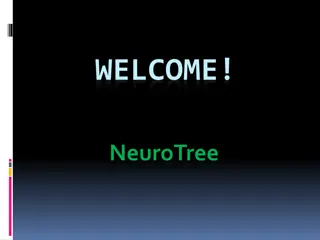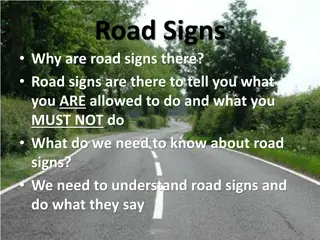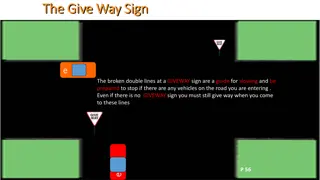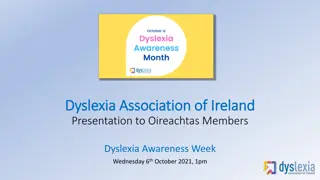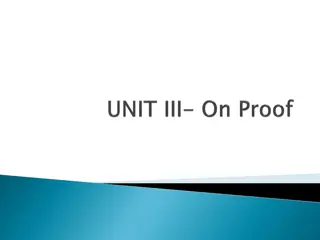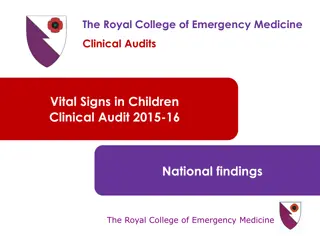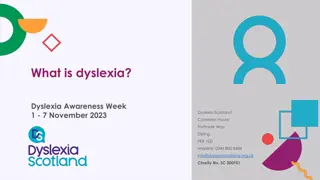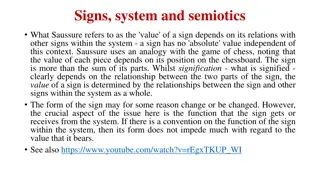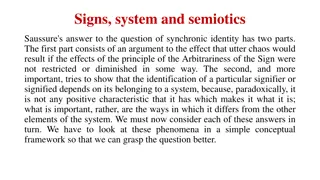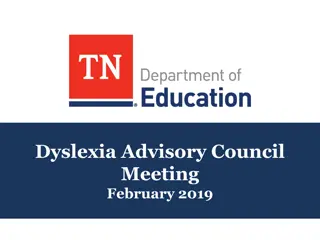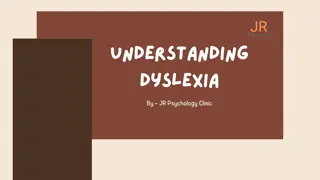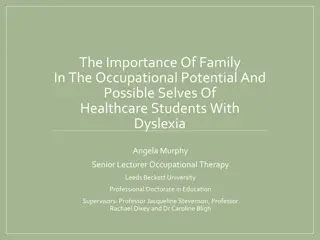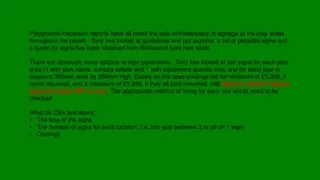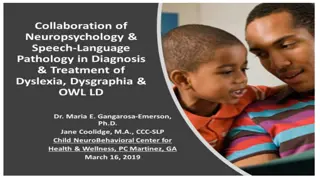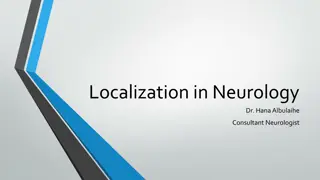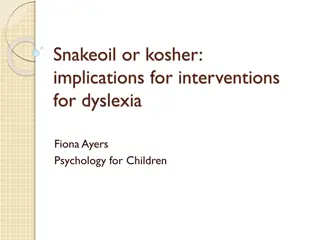Understanding Dyslexia: Facts, Signs, and Strategies for School Support
Dyslexia is a common learning difficulty that impacts word reading and spelling skills. This presentation by Sue Hoult & Hilary Bohl explores the prevalence of dyslexia in classrooms, its characteristics, familial links, early intervention benefits, and misconceptions to dispel. Highlighting varied strengths and weaknesses in individuals with dyslexia, it emphasizes the importance of creating dyslexia-friendly environments in schools and classrooms. The presentation also addresses misconceptions, such as dyslexia being language-specific and the role of brain imaging. Effective strategies for recognizing, supporting, and empowering dyslexic learners are discussed to enhance awareness and inclusivity in educational settings.
Download Presentation

Please find below an Image/Link to download the presentation.
The content on the website is provided AS IS for your information and personal use only. It may not be sold, licensed, or shared on other websites without obtaining consent from the author. Download presentation by click this link. If you encounter any issues during the download, it is possible that the publisher has removed the file from their server.
E N D
Presentation Transcript
DYSLEXIA DYSLEXIA A POWERPOINT PRESENTATION TO HELP SCHOOLS DELIVER CPD INCLUDING: RAISING AWARENESS OF DYSLEXIA AND WHAT SIGNS TO LOOK FOR CREATING DYSLEXIA FRIENDLY CLASSROOMS AND SCHOOLS STRATEGIES TO HELP WITH SUPPORTING PUPILS WITH DYSLEXIA BY: SUE HOULT & HILARY BOHL
Are these statements TRUE or FALSE? There are dyslexic pupils in most, if not all, classrooms Dyslexia may occur in children of all abilities. Individuals with dyslexia can show different strengths and weaknesses. Dyslexia runs in families Reversing letters and writing words backwards are signs of dyslexia Dyslexia occurs on a continuum: difficulties can be slight, moderate or severe. Dyslexia occurs in both males and females but is far more common in males. The earlier the recognition and intervention the better. Children will grow out of dyslexia- they just need time There may be overlapping characteristics between other specific learning difficulties eg dyspraxia, ADHD You only find dyslexia in people who speak English Brain imaging has shown differences in specific areas of Research suggests that 4 5% of all ability children may be severe dyslexics; 10% are affected at different levels and in different ways. the dyslexic brain compared to non-dyslexic brains. Dyslexic learners can do as well as anyone else Dyslexia is a problem of visual perception
Are these statements TRUE or FALSE? There are dyslexic pupils in most, if not all, classrooms Dyslexia may occur in children of all abilities. TRUE TRUE Individuals with dyslexia can show different strengths and weaknesses. TRUE Dyslexia runs in families TRUE Dyslexia occurs on a continuum: difficulties can be slight, moderate or severe. Reversing letters and writing words backwards are signs of dyslexia TRUE FALSE Dyslexia occurs in both males and females but is far more common in males. FALSE The earlier the recognition and intervention the better.TRUE Children will grow out of dyslexia- they just need time FALSE TRUE There may be overlapping characteristics between other specific learning difficulties eg dyspraxia, ADHD You only find dyslexia in people who speak English FALSE TRUE Brain imaging has shown differences in specific areas of the dyslexic brain compared to non-dyslexic brains. Dyslexic learners can do as well as anyone else Research suggests that 4 5% of all ability children may be severe dyslexics; 10% are affected at different levels and in different ways. TRUE TRUE Dyslexia is a problem of visual perception FALSE
What is Dyslexia? Dyslexia is a learning difficulty that primarily affects the skills involved in accurate and fluent word reading and spelling. (Rose Review, 2009) Characteristic features of dyslexia are difficulties in phonological awareness, verbal memory and verbal processing speed. Co-occurring difficulties may be seen in aspects of language, motor co-ordination, mental calculation, concentration and personal organisation, but these are not, by themselves, markers of dyslexia. A good indication of the severity and persistence of dyslexic difficulties can be gained by examining how the individual responds or has responded to well-founded intervention.
Dyslexia usually stems Dyslexia usually stems from a weakness in the from a weakness in the processing of language processing of language- - based information: based information: Visual sequential working memory Auditory sequential working memory Information processing Phonological awareness
What causes Dyslexia? A Dyslexic person is predominantly using their right hemisphere of the brain instead of their left to read and spell: less efficient area for reading/ spelling Latest research: the dyslexic brain processes written words differently. The brain regions dyslexics are using to read are not very good at processing phonemes the basic sounds of language. Dyslexic readers have been found to have strong activity in the right side of their brain. Because of the strength of their right brain, they engage this area while performing language tasks, rather than the left side which non-dyslexics use Studies have shown that dyslexia is a condition passed on through families. If you have dyslexia, there is a 40 to 50% chance your child will also have the condition.
LEFT-RIGHT CONFLICT Say the COLOUR and not the word YELLOW BLUE ORANGE BLACK RED GREEN PURPLE YELLOW RED ORANGE GREEN PINK BLUE RED PURPLE GREEN BLUE ORANGE
SIGNS TO LOOK FOR: EARLY INDICATIONS SIGNS TO LOOK FOR: EARLY INDICATIONS POSSIBLE STRENGTHS in building and construction activities; in geometric and pattern activities; in problem-solving activities in imaginative play in creative activities POSSIBLE WEAKNESSES Delay in development of speech and language Difficulties with fine and gross motor skills/ co-ordination Sequencing and/or memory difficulties Difficulties with orientation and direction delay in establishing laterality easily distracted/ poor concentration/ poor listening
AREAS OF POSSIBLE STRENGTHS AND AREAS OF POSSIBLE STRENGTHS AND WEAKNESSES: PRIMARY SCHOOL AGE WEAKNESSES: PRIMARY SCHOOL AGE POSSIBLE STRENGTHS spatial skills; building and making; oral language; sport; non-verbal activities. POSSIBLE WEAKNESSES Language Reading Written work Sequencing/ memory Motor skills Numeracy Behaviour
Memory and the dyslexic child Short term memory Long term memory
Memory and the dyslexic child Short term memory Long term memory
SIGNS TO LOOK FOR GENERAL: Slow speed of processing Poor concentration difficulty following instructions forgets words Difficulties recalling information Short attention span Tiredness / restlessness Poor auditory discrimination Difficulties in literacy Poor organisational skills
SIGNS TO LOOK FOR: BEHAVIOUR work avoidance tactics dreams/doesn t seem to listen Poor concentration- easily distracted class clown/ disruptive/ withdrawn very tired- due to amount of concentration and effort required Low self esteem Frustration Nervous anxiety Shy/introverted Aggressive Lacks confidence
SIGNS TO LOOK FOR IN READING misses out/adds words fails to recognise familiar words; mis-reads small words loses point of story being read/written difficulty picking out the most important points from a passage Poor understanding of rhyme Poor word finding skills Difficulties Labelling poor reading progress Poor decoding skills-difficulties blending words; difficulties reading polysyllabic words difficulty with syllable division/ knowing the beginnings and endings of words unusual pronunciation of words no expression/poor comprehension hesitant/laboured reading
SIGNS TO LOOK FOR IN WRITTEN WORK poor standard compared with oral ability messy work confuses letters that are similar poor handwriting- reversals/badly formed spells a word several different ways in one piece of writing makes anagrams badly set out work poor pencil grip produces phonetic/bizarre spelling-not age appropriate uses unusual sequencing of letters/words
SIGNS TO LOOK FOR IN LANGUAGE History of delayed speech development Processing of language may be slow Difficulty in word labelling ( being able to remember a particular word in speech) May be impulsive Oral language at a higher level than written language Difficulty with pronouncing multisyllabic words, unusual pronunciation of words May have limited understanding of non-verbal communication
SIGNS TO LOOK FOR IN NUMERACY/ SEQUENCING: Confuses number order; symbols Difficulty with the orientation of numbers Difficulty remembering anything in sequential order; recalling number facts and tables Difficulty recording calculations Difficulty with mental maths Difficulty in solving problems Difficulty learning to tell the time Poor time keeping Poor personal organisation Difficulty remembering the day; birth date; the season; the month Difficulty with yesterday; today; tomorrow Remembering order of events Muddled order: words, sentences, stories Following instructions; Telling stories/jokes
SIGNS TO LOOK FOR: Gross and fine motor /spatial difficulties May jump lines in text Letter order confusion when reading Poor left right discrimination; Confused by left/right; up/down; east/west Indeterminate hand preference Performs unevenly from day to day Poor pencil grip; Unable to write on lines or leave spaces between words; Messy work, poor personal organisation Poor time keeping; Difficulty learning time/ concepts Difficulty understanding prepositions Difficulty judging speed and distance Difficulty copying from board, loses track, unable to scan; Difficulty copying shapes Difficulty discriminating similar letters; symbols; numbers
Cross curricula difficulties PE changing time,dressing skills,organisation/storage MUSIC rhythm and beats, recall of sequences,auditory perception areas GEOGRAPHY linking definitions with correct geographical terminology, written work- independent or copied HISTORY recall of dates and major events,sequential elements within a timescale, understanding of time,written work independent or copied. SCIENCE recall of formula,application of the right approach,sequence of the experimental process, following instructions, recalling definitions, recording
Making it dyslexia friendly: Making it dyslexia friendly: the physical environment the physical environment Have an area of the room designated as a quiet area Place analog and digital clocks on the wall, right next to each other Put high frequency words and information that is used often around the room Use buff; cream or pastel backgrounds on computer screens; interactive whiteboards; handouts and displays Use symbols to support written information Use colour coding to highlight curriculum/ subject areas
Making it dyslexia friendly: Making it dyslexia friendly: using dyslexia friendly text using dyslexia friendly text Use Dyslexia friendly fonts: san serif eg Arial; Font size: use 12-14 points Type of paper for children to write on: try coloured (pastel shades); writing paper should be thick enough so that child can t see writing on other side; matt finish rather than gloss Layout for handouts: less text, more diagrams/ pictures
Making it dyslexia friendly: Making it dyslexia friendly: teaching methods teaching methods Use slower speech and simple sentences. Provide worksheets/ writing frames for organizing information for writing tasks Let children use different ways to show their knowledge of a subject/ task Use multi-sensory approaches in your lessons. Differentiate lessons by: changing presentation; working at different levels/ on different elements; reducing amount of work given; giving extra time to complete work; letting them respond in different ways (eg lists; drawing; dictating; Ipad etc) Use ICT to support pupil s learning
You have 1 minute to accurately copy these letters. Use the hand you do not do not write with.
Making it dyslexia friendly Making it dyslexia friendly It s easier to copy from a piece of paper next to them Write a list of simple instructions to help the child organise work OR Give one instruction at a time and let them complete that before giving the next one Highlight key points in a piece of work Don t give them too much to copy, colour code, check that it s correct
Making it dyslexia friendly Making it dyslexia friendly Give activities with definite end targets break down activities into chunks Ensure that there is sufficient time given to over-learning Only give homework once the child has demonstrated an understanding. Arrange the alphabet in a rainbow shape and leave it on permanent display (useful even for older pupils to help them with using a dictionary) Make sure that any feedback given on spelling, punctuation, grammar and maths only reflects that which has been specifically and systematically taught to them. Have a visual timetable up in every classroom
Making it dyslexia friendly Making it dyslexia friendly Put resources on tables/desks/walls to support multi- sensory learning Have displays in the classroom of keywords and info to support organisation Have a visual timetable in every classroom Use multi-sensory teaching approaches wherever possible
A DYSLEXIA FRIENDLY CLASSROOM: A DYSLEXIA FRIENDLY CLASSROOM: SUPPORTING READING SUPPORTING READING listening to the child read: don t come in too quickly when they hesitate; make sure the room is quiet don t force them to read out loud in front of the class Increase their sight vocabulary Reading on through cloze procedure Try coloured overlays
A DYSLEXIA FRIENDLY CLASSROOM: A DYSLEXIA FRIENDLY CLASSROOM: SUPPORTING READING SUPPORTING READING Ruler underneath text Put card/ paper over text with window cut out to reveal just 1 line of text for them to read at a time Structured phonic programme Sound /symbol link Sound sequencing Syllable counting Phoneme counting Onset and rime eg c-at/ m-at/ b-at etc
A DYSLEXIA FRIENDLY CLASSROOM: A DYSLEXIA FRIENDLY CLASSROOM: SUPPORTING READING SUPPORTING READING Give achievable amounts of reading. Check that it is set at an appropriate reading level. Let them sit with a trusted able reader, or a TA. Give them recorded passages and/or allow them to record their answers to comprehension questions.
A DYSLEXIA FRIENDLY CLASSROOM: A DYSLEXIA FRIENDLY CLASSROOM: SUPPORTING READING SUPPORTING READING Let them highlight key words/ salient points and /or number them when answering comprehension questions Ask them to recall information verbally or to draw a diagram or chart to demonstrate their understanding. If capable, they could formulate questions about the text rather than answering pre-set questions.
A DYSLEXIA FRIENDLY CLASSROOM: A DYSLEXIA FRIENDLY CLASSROOM: SUPPORTING WRITING SUPPORTING WRITING Give achievable amounts of written work. Teach pupils to plan their work. Use Mind maps or spider diagrams. Encourage pupils to proof read their work for spelling and/or punctuation. Give key words or encourage pupils to use lists supplied in their support lessons.
A DYSLEXIA FRIENDLY CLASSROOM: A DYSLEXIA FRIENDLY CLASSROOM: SUPPORTING WRITING SUPPORTING WRITING Use writing frames. Encourage the use of comic strip writing to encourage reluctant writers to try. Handwriting and presentation will probably be poor so mark forcontent and not presentation. Use alternative methods of recording where necessary: Flow charts Story boards Diagrams Dictaphone Sentence completion Word process Dictate to a TA
A DYSLEXIA FRIENDLY CLASSROOM: A DYSLEXIA FRIENDLY CLASSROOM: SUPPORTING SPELLING SUPPORTING SPELLING Give a maximum of 5 words in a spelling test; some pupils will need much less than this. Check how many letters they can recall and gear the length of words given to this. Separate phonic and non-phonic words where possible. Give words in spelling patterns and draw these patterns to the pupil s attention where possible. Use onset and rime eg c-at/ m-at/ b-at etc
A DYSLEXIA FRIENDLY CLASSROOM: A DYSLEXIA FRIENDLY CLASSROOM: SUPPORTING SPELLING SUPPORTING SPELLING Teach and encourage pupils to identify syllables in words. Highlight spelling rules where possible. Encourage pupils to learn spellings by the LOOK THINK COVER WRITECHECK method. If the pupil is capable, encourage them to spell check their work. Put all new spelling rules onto index cards and work with the child to review them quickly as a pack of playing cards each day. Encourage them to do this during their holidays too to prevent forgetting.
A DYSLEXIA FRIENDLY CLASSROOM: A DYSLEXIA FRIENDLY CLASSROOM: SUPPORTING SPELLING SUPPORTING SPELLING When marking spellings, tick the letters the child has got right so they can see where they are successful and what they need to change. correcting spelling: write word for pupil then pupil to: look; write over top naming letters; cover; write from memory; check; repeat if incorrect. Use mnemonics
A DYSLEXIA FRIENDLY CLASSROOM: A DYSLEXIA FRIENDLY CLASSROOM: SUPPORTING NUMERACY SUPPORTING NUMERACY Vocabulary work eg ensure knowledge of prepositional language Make it practical- use concrete objects etc Move from concrete to abstract Method cards Colour code place value TH H T U Display methods with simple examples Chunk information Structure and ensure previous step is secure Convert sums into everyday practical problems Use a visual approach for recording Teach right and left
A DYSLEXIA FRIENDLY CLASSROOM: A DYSLEXIA FRIENDLY CLASSROOM: GENERAL SUPPORT GENERAL SUPPORT Sit near the teacher Place centrally and facing the whiteboard Encourage the child to repeat back instructions/messages Present material in small logical chunks
A DYSLEXIA FRIENDLY CLASSROOM: A DYSLEXIA FRIENDLY CLASSROOM: GENERAL SUPPORT GENERAL SUPPORT Give extra time for work Give clear worksheets: bold headings; clear print; less writing; more diagrams Give lists of useful topic/subject words Use a multi-sensory approach
POINTS TO REMEMBER POINTS TO REMEMBER Don t expect reading and spelling skills to improve at the same time Don t expect them to use a dictionary properly Give plenty of praise and recognition for the things they can do/attempt to do Recognise their strengths Use a multi-sensory approach Dyslexic children need constant over-learning
POINTS TO REMEMBER POINTS TO REMEMBER A dyslexia friendly classroom begins with a dyslexia friendly teacher. The first step toward making your classroom dyslexia friendly is to learn about and understand dyslexia. Understand how dyslexia impacts on a child's ability to learn.
AND ABOVE ALL: AND ABOVE ALL: The strategies you implement in your class for children with dyslexia will benefit all of the children in your class. When you makes changes to help children with dyslexia, you are making positive changes for the entire class.
USEFUL RESOURCES USEFUL RESOURCES A Hand for Spelling- Cripps ACE Dictionaries Spell checkers Wooden/magnetic letters- lower and upper case Mind Maps for Kids: Max your Memory and Concentration- Tony Buzan Eye Track Inclusion Development Programme- Dyslexia Clicker 5 Lexia Nessy Word Shark Toe by Toe Multi-Sensory Learning Programme Alpha to Omega Active Literacy Kit (ALK) Beat Dyslexia
The following slides are aimed at supporting children at secondary school. Other slides from the presentation are suitable to use with these, and many of the strategies use at primary school will still be appropriate for secondary school pupils.
Secondary school age: signs to look for Secondary school age: signs to look for Many of the possible indicators at the primary stage are still relevant for pupils at secondary school age An indicator to consider may be a low SATs result in literacy, with higher results where the pupil has had support from readers or amanuensis. Reading and spelling scores from tests will also be poor, and may be considerably lower than the pupil s chronological age. Also look at your Year 7 baseline assessments ie CATs etc.
AREAS OF POSSIBLE STRENGTHS AND AREAS OF POSSIBLE STRENGTHS AND WEAKNESSES: SECONDARY SCHOOL AGE WEAKNESSES: SECONDARY SCHOOL AGE POSSIBLE STRENGTHS Spatial skills Creative, imaginative and practical skills Oral skills Verbal responses to questions showing good recall Sport or some types of sport POSSIBLE WEAKNESSES Memory Phonological processing and language Sequencing Synthesising information Emotional/behavioural
SUPPORTING SECONDARY AGE PUPILS SUPPORTING SECONDARY AGE PUPILS 1) TRANSITION TO SECONDARY: THE 1) TRANSITION TO SECONDARY: THE DIFFICULTIES DIFFICULTIES lot more teachers and children have to remember names Changes of classrooms every period have to get new locations Finding their way around directional difficulties Timetables have to know where they should be and when More books and equipment what is needed each day is different Lots of homework what to do each evening needs organisation New terminology in subjects information overload New support staff
SUPPORTING SECONDARY AGE PUPILS SUPPORTING SECONDARY AGE PUPILS 1) TRANSITION TO SECONDARY: HOW TO HELP 1) TRANSITION TO SECONDARY: HOW TO HELP HOME Ask the parents to help the pupil to colour code their timetable. Use pictures to help the pupil remember the subjects on the timetable Have 5 box files or file holders for each day of the week at home to help with planning ahead put a big copy of their timetable on their bedroom wall or somewhere it can be seen easily. Ask parents to remind their child each evening what day it is and what equipment is needed for the next day. Get the pupil to prepare their bag the night before. SCHOOL Provide colour coded map of the school and names of staff linked to colour coded areas Use pictures to help the pupil remember the subjects on the timetable Help the pupil to colour code books/ equipment and match it to a colour on the timetable. Daily diaries and/or homework diaries with specific messages/ information, eg link with room location, and days where specific equipment should be in school- books, PE kit A buddy system can also be useful. provide a glossary of terms used in new subjects so the pupil can find out the meaning of words before the work begins. Colour coding is useful, as it allows visual scanning and reading and develops links to aid memory.
SUPPORTING SECONDARY AGE PUPILS SUPPORTING SECONDARY AGE PUPILS 2) GOOD PRACTICE FOR ALL STAFF: 2) GOOD PRACTICE FOR ALL STAFF: knowing who the dyslexic pupils are; having an understanding of dyslexia, with possible strengths, weaknesses and implications for their subject; having knowledge of individual pupils strengths and weaknesses; UNDERSTANDING HOW TO MAKE LESSON ADAPTATIONS: introducing lesson objectives; incorporating differentiation in lessons; presenting information in an accessible way; using cues for recall; using multi-sensory approaches; reducing amounts of and using alternatives to copying.
SUPPORTING SECONDARY AGE PUPILS SUPPORTING SECONDARY AGE PUPILS 3) STRATEGIES TO HELP LEARNING: 3) STRATEGIES TO HELP LEARNING: SPELLING: Find another word that will do for now Say the word and segment the sounds Split the word into syllables. Hip-po-pot-a-mus Use a mneumonic EG, special The CIA have special agents Think about other words that sound the same. Can you use what you know about spelling similar words to help you? Fish dish wish Use a dictionary, spelling log, word bank or classroom display to help you. The Ace dictionary is a must have. Avoid marking all incorrect spellings but highlight one or two to concentrate on
SUPPORTING SECONDARY AGE PUPILS SUPPORTING SECONDARY AGE PUPILS 3) STRATEGIES TO HELP LEARNING: 3) STRATEGIES TO HELP LEARNING: presenting material in a variety of ways; reducing teacher talk time keep to objectives; giving examples of general and specific concepts; using spreadsheets; mind mapping approaches; chunking information; linking subject-specific words with definitions;


